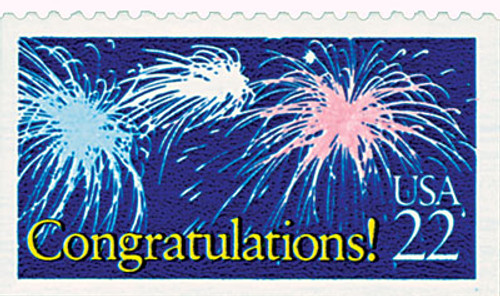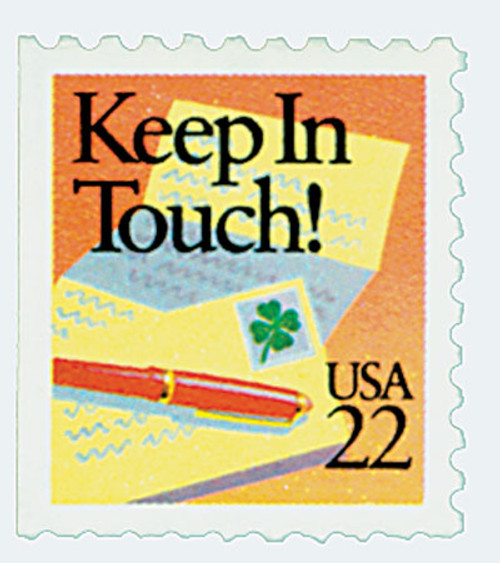
# 2267-74 - 1987 22c Special Occasions
U.S. #2267-74
1987 22¢ Special Occasions
8 Booklet Stamps
- First “special” stamp booklet, which would remain on sale longer than regular stamps
- First US booklet to have the UPC bar code on the cover
- First US stamps to be specifically created for a specialized retail market and sold through card stores and florists
- First US booklet to have stamps in three different configurations.
Stamp Category: Commemorative
Set: Special Occasions
Value: 22¢, first-class rate
First Day of Issue: April 20, 1987
First Day City: Atlanta, Georgia
Quantity Issued: 76,303,125 booklet panes
Printed by: Bureau of Engraving and Printing
Printing Method: Photogravure
Format: Booklet panes of 10
Perforations: 10 on 1, 2, or 3 sides
Why the stamps were issued: In response to calls for stamps that could frank mail for special occasions.
About the stamp designs: These were the first stamps designed by Oren Sherman. He produced the designs based on messages provided by the Citizens’ Stamp Advisory Committee and the USPS. The designs on the stamps include:
“Congratulations” with fireworks
“Get Well!” with Irish flowers
“Thank You!” with balloons
“Love You, Dad!” with a cup of coffee, glasses, and a crossword puzzle
“Best Wishes!” with a four-leaf clover
“Happy Birthday!” with a slice of cake and candle
“Love You, Mother!” with Gerber daisies
“Keep In Touch!” with a letter, an envelope franked with the “Best Wishes” stamp and a pen
First Day City: During the planning process for these stamps, the USPS talked extensively about issuing them in May 1987 at the New York City trade show of a stationers’ group. However, as the date drew nearer, they realized that the trade show would take place after Mother’s Day, and with one of the stamps ideal for that holiday, they wanted to issue the booklet beforehand. So instead, they moved the ceremony to Atlanta, Georgia on April 20, 1987. Among those present for the ceremony was Martha Burke, National American Mother of the Year.
About the Special Occasions Set: For several years, the USPS received requests for stamps for special occasions such as Mother’s Day, Father’s Day, weddings, graduations, birthdays, and more. In the mid-1980s, the USPS began addressing these requests.
The Special Occasions booklet began with a single stamp. In 1985, the USPS announced it would issue a stamp to mark the 50th anniversary of American Mothers, Inc. in 1986. However, as they discussed the stamp and the public requests further, the idea grew into what they called the Messages booklet, and later the Special Occasions booklet.
As the USPS moved forward with the project, they did something they hadn’t done before. They started working with florists and the greeting card industry, trying to see if they would be interested in seeing these new stamps in their stores. The USPS encouraged them to poll their respective associations. They wanted to know if there would be interest in selling these stamps in their stores. If successful, the Special Occasions stamps could be sold in stationery stores, card shops, large supermarkets, and other non-postal outlets. And if the stamps were popular enough, they could be as big for the USPS as Love and Christmas stamps.
In September 1986, the final eight stamp designs were revealed at a meeting of the Greeting Card Association. It was announced that the booklets would have 10 stamps, with two of the designs (Congratulations and Happy Birthday) being repeated, selling for a total of $2.20. This was also the first US booklet to have the UPC (Universal Product Code) bar code on the cover.
When the stamps were released, the USPS said that they “classified them as special stamps because they would remain on sale longer than commemorative stamps.” The stamps were to remain on sale for the remainder of the year, making them the USPS’s first “special” stamp booklet. They were the first US stamps to be specifically created for a specialized retail market, the first to be sold through card stores and florists, and the first US booklet to have stamps in three different configurations.
History the stamps represent: Greeting cards date back to the ancient Chinese, who sent messages celebrating the New Year and the early Egyptians who sent messages on papyrus scrolls. Handmade greeting cards grew in popularity in Europe in the 1400s. For many years, greeting cards were expensive, but advancements in printing technology and the advent of postage stamps made sending the cards more affordable by the 1850s. Soon cards could be mass produced for occasions throughout the year.
Hallmark Cards, Inc., one of America’s largest greeting card manufacturers, was founded in 1910 by Joyce C. Hall. Previously, Hall had owned a small retail store, but after a captivating conversation with a travelling salesman, he narrowed his focus on postcards. Hall soon recognized that greeting cards would become more popular than postcards. He believed greeting cards “represented class, promised discretion and… were more than a form of communication – they were a social custom.”
U.S. #2267-74
1987 22¢ Special Occasions
8 Booklet Stamps
- First “special” stamp booklet, which would remain on sale longer than regular stamps
- First US booklet to have the UPC bar code on the cover
- First US stamps to be specifically created for a specialized retail market and sold through card stores and florists
- First US booklet to have stamps in three different configurations.
Stamp Category: Commemorative
Set: Special Occasions
Value: 22¢, first-class rate
First Day of Issue: April 20, 1987
First Day City: Atlanta, Georgia
Quantity Issued: 76,303,125 booklet panes
Printed by: Bureau of Engraving and Printing
Printing Method: Photogravure
Format: Booklet panes of 10
Perforations: 10 on 1, 2, or 3 sides
Why the stamps were issued: In response to calls for stamps that could frank mail for special occasions.
About the stamp designs: These were the first stamps designed by Oren Sherman. He produced the designs based on messages provided by the Citizens’ Stamp Advisory Committee and the USPS. The designs on the stamps include:
“Congratulations” with fireworks
“Get Well!” with Irish flowers
“Thank You!” with balloons
“Love You, Dad!” with a cup of coffee, glasses, and a crossword puzzle
“Best Wishes!” with a four-leaf clover
“Happy Birthday!” with a slice of cake and candle
“Love You, Mother!” with Gerber daisies
“Keep In Touch!” with a letter, an envelope franked with the “Best Wishes” stamp and a pen
First Day City: During the planning process for these stamps, the USPS talked extensively about issuing them in May 1987 at the New York City trade show of a stationers’ group. However, as the date drew nearer, they realized that the trade show would take place after Mother’s Day, and with one of the stamps ideal for that holiday, they wanted to issue the booklet beforehand. So instead, they moved the ceremony to Atlanta, Georgia on April 20, 1987. Among those present for the ceremony was Martha Burke, National American Mother of the Year.
About the Special Occasions Set: For several years, the USPS received requests for stamps for special occasions such as Mother’s Day, Father’s Day, weddings, graduations, birthdays, and more. In the mid-1980s, the USPS began addressing these requests.
The Special Occasions booklet began with a single stamp. In 1985, the USPS announced it would issue a stamp to mark the 50th anniversary of American Mothers, Inc. in 1986. However, as they discussed the stamp and the public requests further, the idea grew into what they called the Messages booklet, and later the Special Occasions booklet.
As the USPS moved forward with the project, they did something they hadn’t done before. They started working with florists and the greeting card industry, trying to see if they would be interested in seeing these new stamps in their stores. The USPS encouraged them to poll their respective associations. They wanted to know if there would be interest in selling these stamps in their stores. If successful, the Special Occasions stamps could be sold in stationery stores, card shops, large supermarkets, and other non-postal outlets. And if the stamps were popular enough, they could be as big for the USPS as Love and Christmas stamps.
In September 1986, the final eight stamp designs were revealed at a meeting of the Greeting Card Association. It was announced that the booklets would have 10 stamps, with two of the designs (Congratulations and Happy Birthday) being repeated, selling for a total of $2.20. This was also the first US booklet to have the UPC (Universal Product Code) bar code on the cover.
When the stamps were released, the USPS said that they “classified them as special stamps because they would remain on sale longer than commemorative stamps.” The stamps were to remain on sale for the remainder of the year, making them the USPS’s first “special” stamp booklet. They were the first US stamps to be specifically created for a specialized retail market, the first to be sold through card stores and florists, and the first US booklet to have stamps in three different configurations.
History the stamps represent: Greeting cards date back to the ancient Chinese, who sent messages celebrating the New Year and the early Egyptians who sent messages on papyrus scrolls. Handmade greeting cards grew in popularity in Europe in the 1400s. For many years, greeting cards were expensive, but advancements in printing technology and the advent of postage stamps made sending the cards more affordable by the 1850s. Soon cards could be mass produced for occasions throughout the year.
Hallmark Cards, Inc., one of America’s largest greeting card manufacturers, was founded in 1910 by Joyce C. Hall. Previously, Hall had owned a small retail store, but after a captivating conversation with a travelling salesman, he narrowed his focus on postcards. Hall soon recognized that greeting cards would become more popular than postcards. He believed greeting cards “represented class, promised discretion and… were more than a form of communication – they were a social custom.”

















